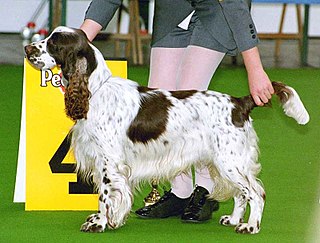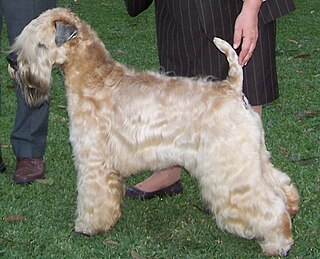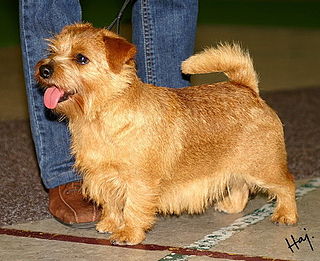
The Scottish Terrier, popularly called the Scottie, is a breed of dog. Initially one of the highland breeds of terrier that were grouped under the name of Skye Terrier, it is one of five breeds of terrier that originated in Scotland, the other four being the modern Skye, Cairn, Dandie Dinmont, and West Highland White Terriers. They are an independent and rugged breed with a wiry outer coat and a soft dense undercoat. The First Earl of Dumbarton nicknamed the breed "the diehard". According to legend, the Earl of Dumbarton gave this nickname because of the Scottish Terriers' bravery, and Scotties were also the inspiration for the name of his regiment, The Royal Scots, Dumbarton’s Diehard. Scottish Terriers, also known as Scotties, were originally bred to hunt vermin on farms.

The Staffordshire Bull Terrier is a British breed of short-haired terrier of medium size. It originated in the Black Country of the English Midlands. It is the direct descendant of the bull and terrier cross-bred from the Old English Bulldog and the Old English Terrier.

A dog show is an event where dogs are exhibited. A conformation show, also referred to as a breed show, is a kind of dog show in which a judge, familiar with a specific dog breed, evaluates individual purebred dogs for how well the dogs conform to the established breed type for their breed, as described in a breed's individual breed standard.

The Soft-coated Wheaten Terrier is a pure-breed terrier originating from Ireland. Wheatens typically have one of two coat types: Irish or Heavy (American). The Irish coat is generally silkier and wavier than the Heavy, or American coat, which is thicker and fuller. Wheatens are generally friendly and playful, and tend to get along well with children and other dogs.

The Bedlington Terrier is a breed of small dog named after the mining town of Bedlington, Northumberland in North East England. Originally bred to hunt, the Bedlington Terrier has since been used in dog racing, numerous dog sports, as well as in conformation shows and as a companion dog. It is closely related to the Dandie Dinmont Terrier, Whippet and Otterhound.

The Boston Terrier is a breed of dog originating in the United States of America. This "American Gentleman" was accepted in 1893 by the American Kennel Club as a non-sporting breed. Color and markings are important when distinguishing this breed from the AKC standard. They should be either black, brindle or seal with white markings. Boston Terriers are small and compact with a short tail and erect ears. The AKC says they are highly intelligent and very easily trained. They are friendly and can be stubborn at times. The average life span of a Boston Terrier is around 11 to 13 years.

The Cairn Terrier is a terrier breed originating in the Scottish Highlands and recognized as one of Scotland's earliest working dogs. The breed was given the name Cairn because the breed's function was to hunt and chase quarry between the cairns in the Scottish highlands.

The American Bulldog is a large breed of utility dog descended from the Old English Bulldog. They are now used on animal farms, dog sports, and for showing. They are part of American culture and history, and may be used as a cultural icon for the United States. They are generally represented as being strong and tough. In November 2019, the American Bulldog was added to the American Kennel Club (AKC) Foundation Stock Service (FSS).

The Irish Terrier is a dog breed from Ireland, one of many breeds of terrier. The Irish Terrier is considered one of the oldest terrier breeds. The Dublin dog show in 1873 was the first to provide a separate class for Irish Terriers. By the 1880s, Irish Terriers were the fourth most popular breed in Ireland and Britain.

The French Bulldog, French: Bouledogue Français, is a French breed of companion dog or toy dog. It appeared in Paris in the mid-nineteenth century, apparently the result of cross-breeding of Toy Bulldogs imported from England and local Parisian ratters. It is a stocky, compact dog with a friendly, mild-mannered temperament.

The Kerry Blue Terrier is a breed of dog. Originally bred to control vermin including rats, rabbits, badgers, foxes, otters and hares, over time the Kerry became a general working dog used for a variety of jobs including herding cattle and sheep, and as a guard dog. Today the Kerry has spread around the world as a companion and working dog. Despite a Kerry Blue winning Crufts in 2000, it remains an "unfashionable" breed, and is distinctly uncommon; however, it is not as threatened as some of the other terrier breeds such as the Skye Terrier, Sealyham Terrier, and Dandie Dinmont Terrier.

The Norwich Terrier is a breed of dog originating in the United Kingdom, and was bred to hunt small rodents. With a friendly personality, Norwich Terriers are today mostly a companion dog breed. One of the smallest terriers, these dogs are generally healthy, but are relatively rare, due in part to their low litter size and the common need for caesarian sections. Their drop-eared variety is the Norfolk Terrier. Recognized as the "official breed of England" in 1932, Norwich Terriers have been delighting owners around the world as a hardworking, loyal companion dogs for nearly a century.

The American Staffordshire Terrier, also known as the AmStaff or American Staffy is a medium-sized, short-coated American dog breed.

The Glen of Imaal Terrier is a breed of dog of the terrier category and one of four Irish terrier breeds. It is sometimes called the Irish Glen of Imaal Terrier or the Wicklow Terrier, and the name of the breed is often shortened by fanciers to just Glen.

The Norfolk Terrier is a British breed of dog. Prior to gaining recognition as an independent breed in 1964, it was a variety of the Norwich Terrier, distinguished from the "prick eared" Norwich by its "drop ears". Together, the Norfolk and Norwich Terriers are the smallest of the working terriers.

An earthdog test or earthdog trial tests the working ability and instinct of the small, often short-legged terriers or Dachshunds. These dogs were bred to hunt vermin and other quarry which lived in underground dens. Earthdog den tests involve man-made tunnels that the dogs must navigate, while scenting a rat, "the quarry." The dog must follow the scent to the quarry and then "work" the quarry. Depending on the sanctioning organization, “working” means barking, scratching, staring, pawing, digging; any active behavior. The quarry is protected at all times by wooden bars across the end of the tunnel. The hunting encounter is controlled, and neither the dog nor the quarry are endangered by the activity.
The Irish Kennel Club or IKC is an organization dedicated to supporting dog breeds and their owners.
Game or gameness is a quality of fighting dogs and working terriers that are selectively bred and conditioned from a very early age to develop traits of eagerness despite the threat of substantive injury. Dogs displaying this trait can also be described as persevering, ready and willing, full of fight, spirited, or plucky.

A working terrier is a small type of dog which pursues its quarry into the earth. According to the Oxford English Dictionary, the name dates back to at least 1440, derived from French chien terrier 'digging dog', from Medieval Latin terrarius, ultimately from Latin terra (earth).
The American Dog Breeders Association (ADBA) is a kennel club founded in 1909 in the United States. It is one of two official registries in the US for the American Pit Bull Terrier (APBT); the other is the United Kennel Club (UKC). ADBA was co-founded as an all-breed registry in 1909 by Guy McCord and Con Feeley as to promote John Colby's strain of pit bulls and establish an American Pit Bull Terrier registry. ADBA is located in Salt Lake City, Utah, and sponsors conformation dog shows, weight pulling competitions, and Top Dog Athletic Events consisting of three canine competitions: treadmill race, wall climb and lure coursing. The modern registry focuses primarily on the American Pit Bull Terrier with a few exceptions.
















